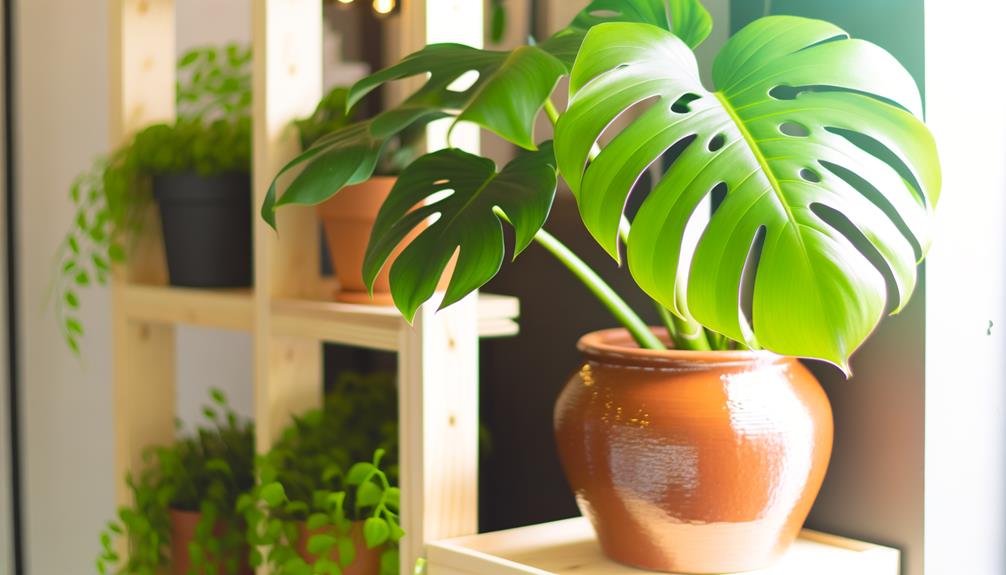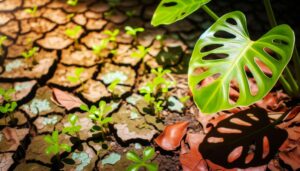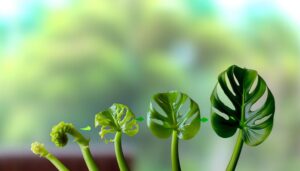Monstera Lechleriana Care Guide
Safeguard your Monstera lechleriana thrives by situating it in bright, indirect light, preferably near an east-facing window with sheer curtains. Sustain the top inch of soil dryness, watering every 7-10 days using room temperature, distilled water.
Use a blend of peat moss, perlite, and orchid bark for soil, with a pH of 5.5-7.0. Keep humidity levels at 60-80% and temperature between 65°F and 80°F.
Fertilize with a balanced, water-soluble feed, reducing in fall, and suspending in winter. Regularly check for pests and propagate using stem cuttings.
Discover detailed steps and seasonal adjustments next.

Key Takeaways
- Place Monstera lechleriana in bright, indirect light and avoid direct sunlight to prevent leaf burn.
- Water every 7-10 days, ensuring the top inch of soil is dry before watering.
- Maintain high humidity (60-80%) and keep temperatures between 65°F and 80°F.
- Use a well-draining soil mix of peat moss, perlite, and orchid bark for optimal growth.
- Regularly inspect for pests and use neem oil treatments as needed to maintain plant health.
Light Requirements
To maximize growth for your Monstera lechleriana, place it in bright, indirect light, as direct sunlight can scorch its leaves. Positioning near an east-facing window provides prime photoperiods without excessive light intensity. Use sheer curtains or place the plant slightly away from the window to diffuse the light.
Monstera lechleriana thrives in a luminous environment mimicking its native understory habitat. Monitor leaf color; pale or yellowing leaves indicate too much light, while dark green leaves suggest insufficient light. Rotate the plant periodically to guarantee even light exposure and symmetrical growth.
If natural light is inadequate, supplement with full-spectrum grow lights, ensuring a photoperiod of 12-14 hours. Consistent light levels promote healthy photosynthesis and robust development.
Watering Schedule
When establishing a watering schedule for your Monstera lechleriana, maintain a frequency that allows the top inch of soil to dry out between waterings.
Adjust your watering practices seasonally, as the plant's needs will vary with changes in temperature and humidity.
Watch for signs of overwatering, such as yellowing leaves and root rot, to prevent compromising the plant's health.
Ideal Watering Frequency
A consistent watering schedule for Monstera Lechleriana is crucial, typically requiring thorough hydration every 7-10 days, depending on environmental factors such as temperature and humidity.
Ensure the substrate, preferably a mix of peat, perlite, and orchid bark, remains evenly moist but not waterlogged. Insert your finger about 2 inches into the soil; if it's dry, it's time to water. Use room temperature, distilled water to avoid mineral build-up. Water slowly until you see drainage from the pot's bottom.
Monitor for signs of overwatering, like yellowing leaves, or underwatering, such as curling leaves. Maintaining balanced moisture levels will promote optimal growth and prevent root rot (Rhizoctonia solani).
Adjust based on microclimate variations within your home.
Seasonal Watering Adjustments
Adjust your Monstera Lechleriana watering schedule for seasonal changes by increasing frequency during the growing months of spring and summer, and scaling back in the dormant periods of fall and winter. During the active growth phase, aim to keep the soil consistently moist. You should water when the top 2-3 inches (5-7 cm) of soil feel dry to the touch.
In contrast, during the colder months, allow the soil to dry out more thoroughly between waterings. This is essential to prevent root rot (Phytophthora spp.) and other fungal issues. Use tepid water to avoid shocking the roots (primary root system).
Regularly monitor the soil moisture using a hygrometer for precise adjustments. Your plant will thrive with these seasonal adjustments.
Signs of Overwatering
Overwatering your Monstera Lechleriana can manifest through yellowing leaves, root rot (Phytophthora spp.), and a persistent musty smell from the soil. To prevent damage, monitor these specific symptoms:
- Yellowing Leaves: Excess water disrupts nutrient uptake, causing chlorosis.
- Root Rot (Phytophthora spp.): Roots become mushy, brown, and lose function.
- Musty Soil Odor: Anaerobic conditions promote microbial growth, emitting a musty smell.
- Wilting Despite Moist Soil: Saturated roots struggle to oxygenate, leading to plant stress.
Ensure you're using a well-draining soil mix and allow the top inch of soil to dry out before watering again. Adjust your watering schedule based on seasonal changes and environmental conditions to maintain ideal soil moisture levels.
Soil Preferences
Why is a well-draining, aerated soil mix, made up of peat moss, perlite, and orchid bark, necessary for Monstera lechleriana's optimal growth?
It guarantees adequate root aeration and prevents waterlogged conditions, which can result in root rot (Pythium spp.).
Begin with a base of peat moss for moisture retention.
Blend in perlite, which improves drainage and aeration, ensuring the roots receive ample oxygen.
Integrate orchid bark to provide structure and replicate the plant's natural epiphytic environment, encouraging healthy root development.
Aim for a pH range of 5.5-7.0.
Regularly check the soil's texture, adjusting the mix as needed.
Proper soil composition is essential for nutrient absorption, vitality, and overall well-being of Monstera lechleriana (Monstera adansonii var. lechleriana).
Humidity Needs
Maintaining high humidity levels, around 60-80%, is essential for Monstera lechleriana as it mimics its native tropical rainforest environment, ensuring ideal leaf development and preventing desiccation.
You can achieve this by employing several techniques:
- Humidifiers: Place a humidifier near your Monstera to maintain consistent moisture in the air.
- Pebble Trays: Position the plant pot on a tray filled with water and pebbles to promote evaporation and increase surrounding humidity.
- Misting: Regularly mist the leaves with distilled water to provide immediate humidity, especially in drier conditions.
- Grouping Plants: Cluster your Monstera with other humidity-loving plants like Epipremnum aureum or Philodendron hederaceum to create a microenvironment with higher humidity levels.
These methods will help your Monstera lechleriana thrive.
Temperature Range
Monstera lechleriana thrives in temperatures ranging from 65°F to 80°F (18°C to 27°C), reflecting its native tropical climate. It's essential to maintain this temperature range to guarantee peak growth and health. Avoid exposing the plant to temperatures below 60°F (15°C), as this can cause stress and slow growth. Conversely, temperatures above 85°F (29°C) may lead to rapid water loss and potential leaf burn.
Place your Monstera lechleriana in a location where temperature fluctuations are minimal. Avoid drafts from windows, doors, and air conditioning units. During colder months, keep the plant away from heating vents and ensure it doesn't experience sudden temperature drops.
Consistent monitoring with a reliable thermometer can help maintain ideal conditions.
Fertilization Tips
For best growth, use a balanced liquid fertilizer with a 20-20-20 NPK ratio for your Monstera lechleriana. Apply the fertilizer biweekly during the growing season from spring to early autumn.
Be cautious not to over-fertilize, as this can lead to nutrient burn and root damage.
Optimal Fertilizer Types
Selecting the right fertilizer is crucial for Monstera lechleriana, with balanced, slow-release granular fertilizers being particularly effective in providing essential nutrients. You'll want to choose a fertilizer with a balanced N-P-K ratio, such as 5-5-5 or 10-10-10, to make sure your plant receives a steady supply of nitrogen, phosphorus, and potassium. Avoid high-nitrogen formulas, as they can cause excessive foliage growth at the expense of root development.
To help you select the best fertilizer, consider the following options:
- Balanced granular fertilizer (5-5-5 or 10-10-10)
- Organic fertilizers like worm castings or compost
- Water-soluble fertilizers for quick nutrient uptake
- Micronutrient-rich fertilizers containing iron, magnesium, and calcium
Proper fertilization promotes healthy growth and vibrant foliage in your Monstera lechleriana.
Seasonal Feeding Schedule
To optimize your Monstera lechleriana's growth, implement a seasonal feeding schedule that aligns with its natural growth cycles and environmental needs. During the growing season, typically spring and summer, apply a balanced, water-soluble fertilizer with an NPK ratio of 20-20-20 biweekly. Dilute the fertilizer to half-strength to prevent root burn and guarantee even nutrient absorption.
In the fall, reduce feeding frequency to once a month as the plant's growth rate slows. During winter dormancy, suspend fertilization entirely to avoid nutrient buildup in the soil. Always water the plant thoroughly before and after fertilizing to facilitate nutrient uptake and prevent salt accumulation.
Adhering to these seasonal guidelines will promote robust, healthy growth for your Monstera lechleriana.
Avoid Over-fertilizing Risks
Over-fertilizing your Monstera lechleriana can lead to salt buildup in the soil, causing root damage and inhibiting nutrient absorption. To prevent this, use a balanced, water-soluble fertilizer. Apply it at half strength during the growing season. Make sure you're not fertilizing during the dormant winter months, as this can harm your plant.
Follow these tips to avoid over-fertilizing:
- Dilution: Always dilute the fertilizer to half the recommended strength.
- Frequency: Fertilize only once a month during spring and summer.
- Type: Use a balanced N-P-K (nitrogen-phosphorus-potassium) fertilizer.
- Watering: Flush the soil with water occasionally to remove excess salts.
Pest Management
Effective pest management for Monstera lechleriana involves regularly inspecting the plant for common pests such as spider mites (Tetranychus urticae) and scale insects (Coccoidea). To manage infestations, use a mixture of neem oil (Azadirachta indica) and water, applying it thoroughly to leaves. Ensure good air flow around the plant to prevent pest proliferation. Quarantine new plants before introducing them to your collection.
Here's a quick guide:
| Pest | Identification | Treatment Method |
|---|---|---|
| Spider Mites | Fine webbing on leaves | Neem oil spray |
| Scale Insects | Brown, shell-like coverings | Rubbing alcohol application |
| Thrips (Thysanoptera) | Silvery streaks, black dots | Insecticidal soap |
| Mealybugs (Pseudococcidae) | White, cotton-like masses | Isopropyl alcohol swab |
| Aphids (Aphidoidea) | Sticky residue, yellowing leaves | Water spray, insecticidal soap |
Regular monitoring and prompt action will keep your Monstera lechleriana healthy.
Propagation Methods
Propagating Monstera lechleriana typically involves stem cuttings, making sure each cutting has at least one node and a healthy leaf. To begin, use sterilized pruning shears to make a clean cut below a node.
Next, place the cutting in water or a moist sphagnum moss medium to encourage root development. Sustain high humidity and indirect light to facilitate growth.
Here's a step-by-step guide:
- Select a healthy stem: Choose a stem with at least one node and a mature leaf.
- Cut below the node: Use sterilized shears to make a clean cut.
- Rooting medium: Place the cutting in water or sphagnum moss.
- Environmental conditions: Make sure high humidity and indirect light.
Following these steps, you'll successfully propagate Monstera lechleriana.
Conclusion
Caring for your Monstera lechleriana is like tending to a delicate symphony. Each element—light, water, soil, humidity, temperature, fertilization, and pest control—is an instrument that must be finely tuned.
When you master this botanical orchestra, you'll witness your Monstera flourish, its fenestrated leaves unfurling like a maestro's baton.
Follow these guidelines, and your plant won't only survive but thrive, becoming the verdant centerpiece of your indoor garden.






